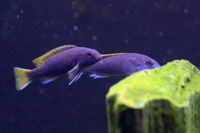Difference between revisions of "Pseudotropheus acei"
From The Aquarium Wiki
m |
|||
| Line 35: | Line 35: | ||
|max_water_hardness=25 | |max_water_hardness=25 | ||
}} | }} | ||
| − | + | ||
| − | + | == Sexing == | |
| − | + | :Males will have 3 or more yellow egg spots while females will have only one if any. Males tend to be slightly larger than females. | |
| − | + | ||
| − | + | ||
| − | + | == Tank compatibility == | |
| − | + | :Keep with other African Cichlids from Lake Malawi, these seem to be slightly less aggressive than others though, so a highly aggressive environment is probably not suited for them. | |
| − | + | ||
| − | + | ||
| + | == Diet == | ||
| + | :In the wild these Cichlids feed on loose algae from rocks. They should be given a vegetarian diet that is low in protein. Algae wafers, algae flakes and blanched zucchini are all acceptable. | ||
| + | |||
| + | |||
| + | == Feeding regime == | ||
| + | :Feed twice a day, or 3 times a day for juveniles. | ||
| + | |||
| + | |||
| + | == Environment specifics == | ||
| + | :Provide lots of caves and a sandy substrate for digging. As with most Malawi Cichlids, the Yellow Tail Acei prefer hard water alkaline water with Cichlid Salts. | ||
| + | |||
| + | |||
| + | == Behaviour == | ||
| + | :As with most African [[:Category:Cichlids|Cichlid]] species, this fish is aggressive and is not suitable for a community tank. | ||
| + | |||
| + | |||
| + | == Identification == | ||
| + | :This fish has a vibrant violet coloured body with yellow fins and tail. The anal fin is white and has egg spots. | ||
| + | |||
| + | |||
{{Categories | {{Categories | ||
|Category=Fish, Fish (Freshwater), Cichlids, Cichlids (African), Cichlids (Lake Malawi) | |Category=Fish, Fish (Freshwater), Cichlids, Cichlids (African), Cichlids (Lake Malawi) | ||
Latest revision as of 03:17, 13 December 2017
Yellow Tail Acei
Pseudotropheus acei
208 Litres (55 US G.)
12.7-15.2cm (5-6 ")
Freshwater
7.8 - 8.6
25.6-27.8°C (78 -82 °F)
15-25 °d
1:2 M:F
5-12 years
Family
Cichlidae
Contents
Additional names
- Yellow-Tailed Acei, Yellow Tail Acei
Sexing[edit]
- Males will have 3 or more yellow egg spots while females will have only one if any. Males tend to be slightly larger than females.
Tank compatibility[edit]
- Keep with other African Cichlids from Lake Malawi, these seem to be slightly less aggressive than others though, so a highly aggressive environment is probably not suited for them.
Diet[edit]
- In the wild these Cichlids feed on loose algae from rocks. They should be given a vegetarian diet that is low in protein. Algae wafers, algae flakes and blanched zucchini are all acceptable.
Feeding regime[edit]
- Feed twice a day, or 3 times a day for juveniles.
Environment specifics[edit]
- Provide lots of caves and a sandy substrate for digging. As with most Malawi Cichlids, the Yellow Tail Acei prefer hard water alkaline water with Cichlid Salts.
Behaviour[edit]
- As with most African Cichlid species, this fish is aggressive and is not suitable for a community tank.
Identification[edit]
- This fish has a vibrant violet coloured body with yellow fins and tail. The anal fin is white and has egg spots.
